Balancing Cost and Quality: GS Caltex’s GDC Transformation Journey
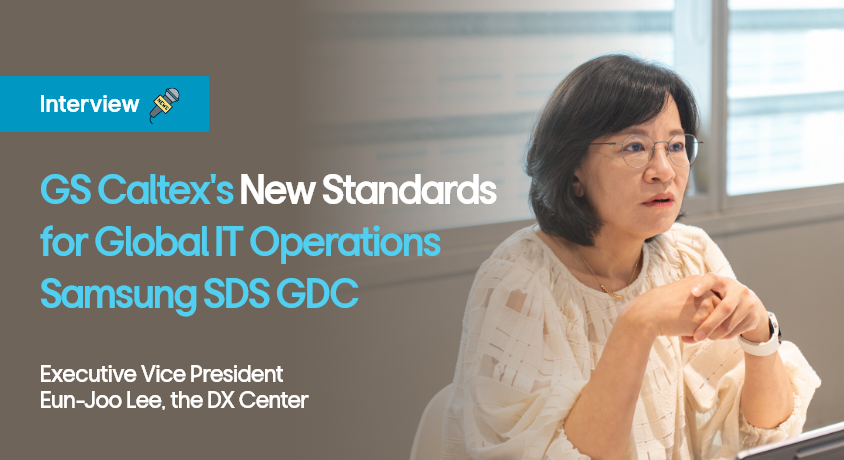
Customer Success Story
Customer Success Story dives into how companies are achieving remarkable growth with the help of Samsung SDS services.Key Summary
- The First Company in the Refining and Chemical Industry to Successfully Adopt a Large-Scale GDC: Established in 1967, GS Caltex, an oil refining giant with annual revenue of 48 trillion won, achieved both cost reduction and enhanced IT operation quality through its GDC transformation.
- Stable Transformation Strategy through a Phased Approach: In partnership with Samsung SDS, GS Caltex began with a pilot project and systematically migrated infrastructure operations followed by common business systems. This careful step-by-step handover minimized risks and ensured a smooth introduction of the GDC.
- Samsung SDS GDC, Game Changer for Global IT Innovation: Operating 24/7 throughout the year, Samsung SDS GDC provides a stable global IT operation system, serving as a key driver of IT innovation.
For the past 58 years, GS Caltex has been at the forefront of Korea’s energy industry. Now, the company is taking the lead in digital transformation (DX). Under the leadership of Executive Vice President Eun-Joo Lee, the DX Center has drawn significant attention across the industry by successfully completing a large-scale GDC adoption project with Samsung SDS—a rare achievement in the refining and chemical sectors.
We sat down with Eunjoo Lee, Head of GS Caltex’s DX Center, to hear how her courage to embrace change and her leadership with a global perspective have driven the company’s groundbreaking digital transformation journey.
"I am your Energy”
Thank you for your time. Could you please introduce yourself?
Nice to meet you. I am Eunjoo Lee, Head of GS Caltex’s DX Center. As both CIO and CDO, I oversee DX initiatives. Experiencing rapid and diverse advancements in IT technology, I firmly believe IT should go beyond simple operational support to become a core driver of business innovation.
Could you tell us about GS Caltex?
Founded in 1967, GS Caltex operates gas stations under the well-known slogan “I am your Energy.” Besides refining, we produce a wide range of petrochemical products. Currently, we have annual sales around 48 trillion KRW and run the world’s fourth largest refinery in Yeosu.
When you think of Yeosu, most people picture a tourist destination. One of the reasons the Yeosu night sea is so beautiful is actually thanks to the petrochemical complex. The lights installed to ensure safety in the complex create a stunning nighttime scenery, and it means that GS Caltex plays a part in lighting up the Yeosu night sea.
The refining industry operates in a continuous process where the product made in the first plant moves to the second plant to become another product. This means the industry blends tradition and innovation, with factories ranging from one built in 1969, now 56 years old, to the latest facilities completed just three years ago.
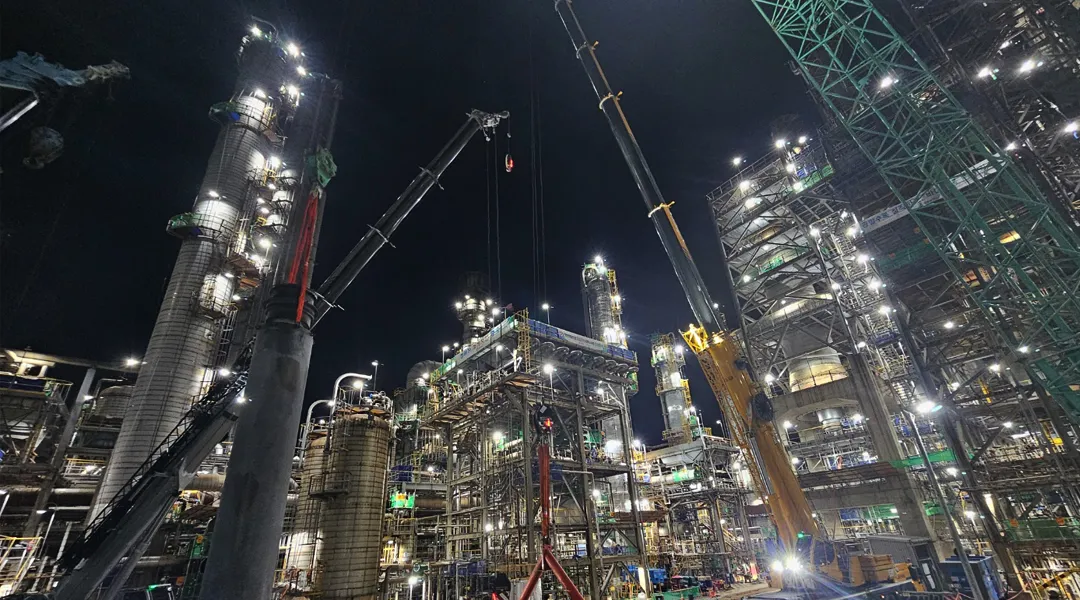 GS Caltex Yeosu Petrochemical Complex lighting up the night sky of Yeosu (Source: GS Caltex Media Hub)
GS Caltex Yeosu Petrochemical Complex lighting up the night sky of Yeosu (Source: GS Caltex Media Hub)
"Changing the Way We Work Through Digital Technology"
What role does the GS Caltex DX Center play?
The GS Caltex DX Center was established in 2019, rooted in the company’s Growth Sustainability vision and the Deep Transformation project. This Deep Transformation consists of three pillars: Business Transformation (BX), Green Transformation (GX), and Digital Transformation (DX), which I lead. Given the petrochemical industry's unique characteristics, fundamental changes are needed to respond effectively to external environmental shifts, and supporting all these changes with digital technologies is the core mission of our DX Center.
In the past, IT team primarily played a support role—developing systems based on requests from business units. If they needed a certain system, the IT team would build and deliver it. But today, everything has changed. The DX department has shifted to a leadership role in driving innovation. We are no longer just developing requested systems, now we lead enterprise-wide digital transformation. We handle everything from testing and adopting new technologies to collecting and analyzing data. Ultimately, designing and executing company-wide digital innovation has become our new identity.
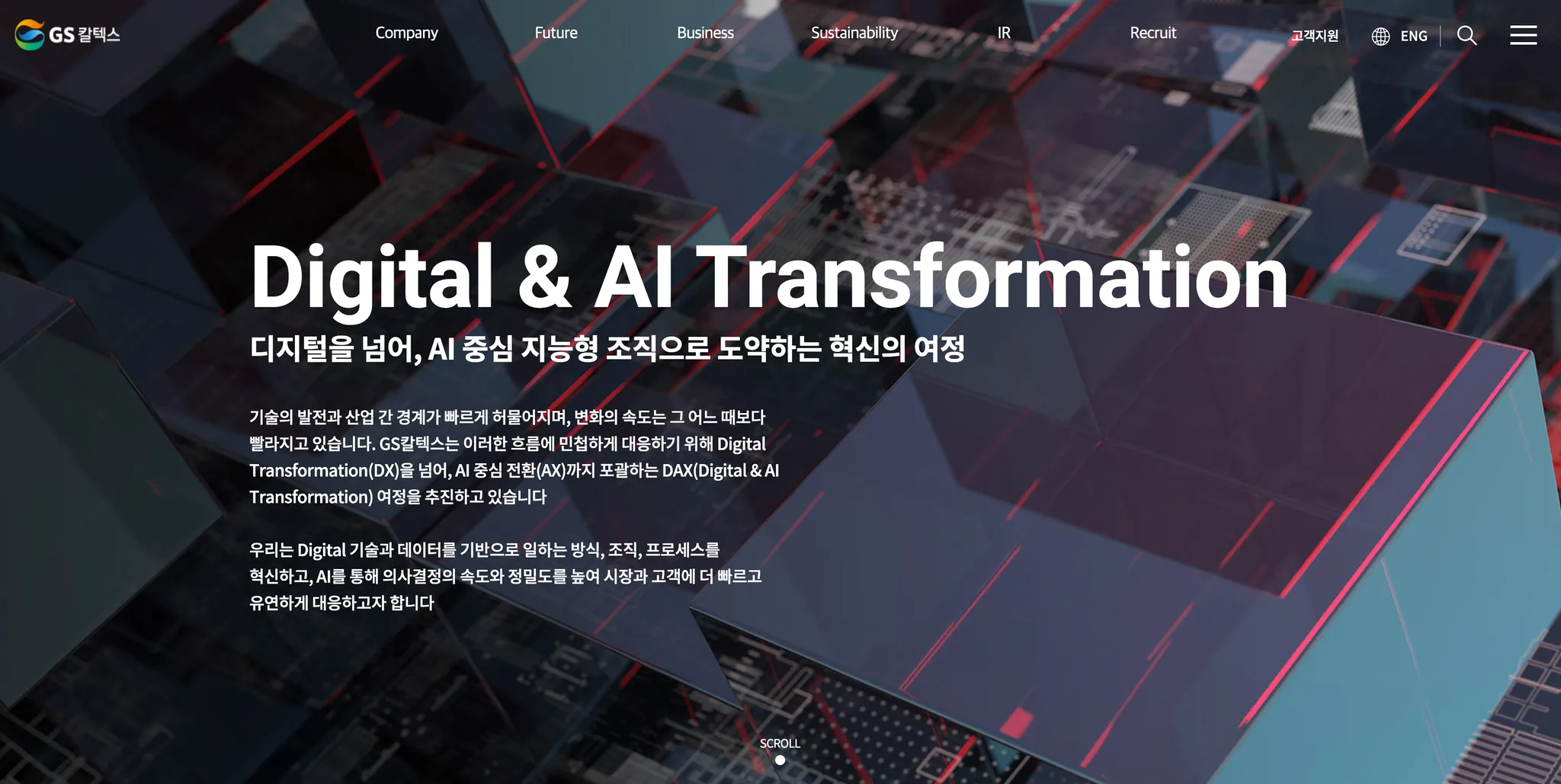 GS Caltex DAX Official Webpage
GS Caltex DAX Official Webpage
"I was thinking about how to secure and utilize top talent at a competitive cost."
I heard that you considered Samsung SDS GDC adoption amid concerns about DX challenges.
When GS Caltex announced its Deep Transformation, each team actively pursued digital innovation within its responsibilities. The production team transformed production methods, logistics digitized their processes, and the procurement team digitalized purchasing, fundamentally changing how they work. But I found one irony. While every department was innovating, the IT team remained focused on just technically supporting those innovations. If another department said, "We need this system," or "We want to automate this task," IT's primary role was simply to build it.
At that point, I wondered, "Why isn't the IT department innovating to cut costs and improve efficiency like other departments?" After all, we also spend operating and investment costs, yet IT cost reduction was never a priority topic. I believed that true innovation meant the IT team also needed to find ways to become more efficient. That's when I started considering the Samsung SDS GDC.
What kind of service is Samsung SDS GDC?
The Global Development Center (GDC) refers to a dedicated center for software development and IT operations established overseas. Samsung SDS GDC is set up in countries like Vietnam, India, and China, which have a strong pool of IT talent yet offer competitive labor costs.
Learn more

Specifically, what needs did you have before adopting GDC?
The key concern was how to secure and utilize talented personnel at a competitive cost.
The annual salary increase for IT personnel has been rising by 8-10%, which is almost three times the national average wage increase of 3.4%. To attract excellent developers and operation experts, providing competitive compensation has become essential.
At the same time, since DX accelerated from 2019, demands for digital transformation had poured in from various departments. Not only the cost to build systems but also ongoing operational expenses kept rising. Under such circumstances, we sought a more efficient way to secure the necessary capabilities, which eventually led us to consider applying Samsung SDS’s GDC at GS Caltex.
Achieve both advanced technology and cost efficiency
with Samsung SDS GDC
"Unfamiliar GDC due to No Prior Experience"
What internal concerns did you have when considering the adoption of GDC?
The initial reaction from our team towards GDC was not very positive. It wasn’t so much prejudice as it was uncertainty—simply because we hadn’t experienced GDC before. The biggest obstacle was our past experience. Some team members faced challenges in managing quality control and project progress when working with overseas companies or solution vendors due to communication breakdown.
On top of that, realistic worries surfaced. There were concerns not only about language barriers but also about whether we could accurately convey our company’s unique business terminology and complex technical details. Many were also cautious about whether quality control and schedule adherence could be properly managed when work is done remotely.
It wasn’t easy to overcome the skepticism and concerns, so how did you handle them?
I thought there were limits to just explaining things verbally. So, I said, "Let's just go and take a look first." In June of last year, we took a business trip to visit Samsung SDS GDC in Vietnam. When our team members stepped inside, their impression was that this building was for a company that truly knows IT tasks. It wasn’t just a gathering of people; the infrastructure to systematically operate IT services was already perfectly in place. Notably, Samsung SDS GDC has accumulated experience over a long time, so we could directly feel their know-how on site.
From automated tools, quality control systems, to security measures, everything was far more structured and professional than we had imagined. The level of the Vietnamese personnel was also very high, and the various frameworks required for typical IT service companies were well established.
As a result, our team’s mindset gradually shifted. Even the team member who was the most opposed initially changed the opinion after the Vietnam trip, saying, "It’s worth a try." We realized firsthand that seeing and experiencing something is the most convincing. At the end of that year, we began consulting with Samsung SDS on whether we could fully implement GDC and kicked off with a small pilot project.
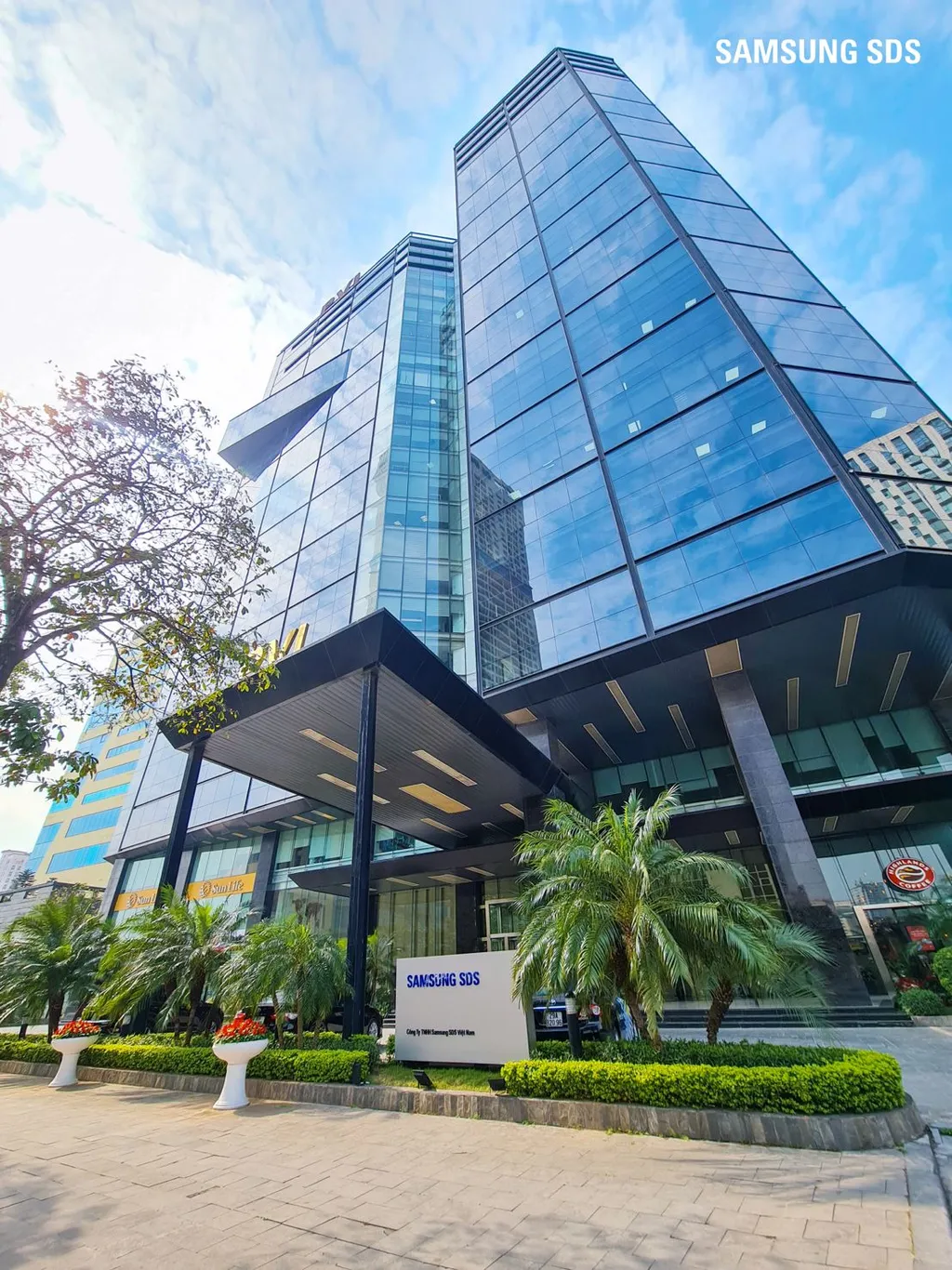 Samsung SDS Vietnam GDC site overview
Samsung SDS Vietnam GDC site overview
"‘Created the GDC Roadmap Together with Samsung SDS"
What process was followed for the adoption of Samsung SDS GDC?
Although we had decided to give it a try, once we actually started, a mountain of concerns piled up. We felt overwhelmed wondering how to proceed, where to begin, and what preparations were necessary. Above all, we needed confidence. We wondered whether we could truly secure the quality and stability we expected at a competitive cost by adopting GDC? Verification was essential.
So, we requested expert consulting from Samsung SDS. We honestly shared the challenges we were facing, and in return, learned from Samsung SDS’s accumulated know-how gained from various experiences of clients’ system migration to GDC. By combining the needs and experience of both sides, we were able to create a customized roadmap tailored specifically for GS Caltex. Yet, no matter how perfect the plan is, there are always unknowns until you actually try it. That’s why we decided to gain firsthand experience through a pilot project.
What did you do in the Samsung SDS GDC pilot project?
Through the pilot project, we built DX Center's work portal. Instead of immediately integrating with other departmental systems, I personally used and experienced it first, and found what was challenging and what exceeded expectations.
The pilot project ran for four months, with two Samsung SDS experts and seven members from the GDC in Vietnam. Though a relatively small-scale project, it was a valuable opportunity to vividly experience how collaboration with GDC works, how quality management is handled, and which communication method is most effective. This positive experience gave us confidence for the full-scale GDC migration ahead, while also helping us identify areas we had overlooked.
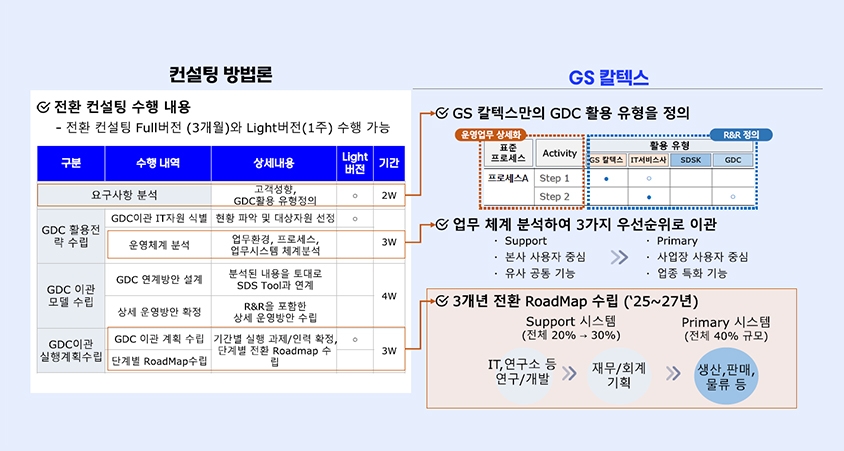 Samsung SDS GDC Consulting and Transformation RoadMap (Source: New Possibilities Opened by GDC Utilization)
Samsung SDS GDC Consulting and Transformation RoadMap (Source: New Possibilities Opened by GDC Utilization)
Now, I’m curious about the actual transformation status. Which areas have been moved to the GDC so far?
We prioritized safety above all and proceeded with a phased approach.
In the first phase, we started migrating infrastructure operations. This covers managing foundational facilities like servers, networks, and databases. Although on-site staff may not feel the importance firsthand, this operations are crucial to ensure all systems run smoothly. We use both cloud and on-premises environments, and especially at the plants, the network is separated for security, so we should manage a large amount of infrastructure. Currently, a significant portion of infrastructure operations has been migrated to the GDC and is being run stably.
In the second phase, we moved business systems that all employees use in common, such as HR, procurement, and legal systems. These systems are used company-wide, but since they involve relatively fewer urgent responses and have standardized processes, they were well suited for early migration to the GDC.
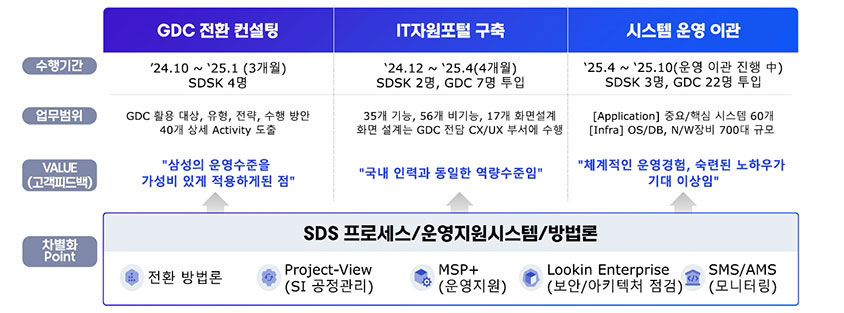 GS Caltex's Samsung SDS GDC Utilization Case (Source: New Possibilities Opened by GDC Utilization)
GS Caltex's Samsung SDS GDC Utilization Case (Source: New Possibilities Opened by GDC Utilization)
Do you have plans to further expand the transition to Samsung SDS GDC in the future?
Yes, we plan to gradually expand it to cover almost all areas. However, we are maintaining a cautious approach. Systems subject to legal regulations, business systems requiring on-site support, and production plant systems will be excluded for the time being due to network separation requirements. Beyond those, though, we intend to proceed with phased transitions according to Samsung SDS GDC’s well-structured roadmap.
I heard you discovered new possibilities through Samsung SDS GDC adoption. Could you share more details?
Yes, we found an opportunity to standardize IT capabilities across our entire global organization. We had been facing a challenge. The headquarters, being large, could invest heavily in IT and significantly improve system quality, but our subsidiaries and overseas branches, with smaller revenues, were falling behind in IT capabilities. Separate IT support lowered efficiency and made standardization difficult.
However, we realized that utilizing the GDC enables the local GDCs to provide direct support to regions like China, Vietnam, and the Czech Republic. While maintaining the headquarters’ IT governance and processes, actual system operations are handled by local GDCs. Thereby, subsidiaries can receive IT services at the same level as the headquarters.
Although a detailed execution plan is not finalized yet, we are very hopeful since GDC can serve not just as a cost-saving tool but as a strategic lever to elevate IT capabilities across our entire global organization.
"Samsung SDS Has Already Established a Perfect Communication System”
How do you communicate and collaborate with local engineers during actual operations?
Samsung SDS has built a perfect communication system while operating GDC for over 10 years. The system has dual-layer structure. The core tasks involve communicating with domestic GDC consultants, while day-to-day interactions happen with Bridge Software Engineers (BSEs).
BSEs are fluent in Korean. When I actually talk with our friends in Vietnam, if I speak Korean, they often giggle beside me. They understand some Korean already, but interpreters are there to ensure clearer communication.
Moreover, Samsung SDS’s Brity Works supports real-time translation and interpretation, capable of handling simultaneous translation in 12 languages. Team members say this interpreting feature is much better than internal online meeting tools when communicating with GDC.
What are the roles and responsibilities of Bridge Software Engineers (BSEs)?
Samsung SDS's BSEs play a critical role as a communication specialist between Korean clients and local development teams at the GDC. BSEs are experts equipped with both IT technical skills and proficiency in Korean. They do more than simple interpretation—they act as facilitators who ensure smooth communication and guide discussions. Their responsibilities include accurately understanding complex technical requirements, conveying them to local developers, and clearly reporting development progress and issues back to the Korean clients.
Samsung SDS currently deploys a total of 294 BSEs across three countries, including about 150 top-level TOPIK (Test of Proficiency In Korean) certified professionals. Thanks to these experts, language barriers are effectively removed, enabling seamless project execution. Especially, when dealing with industry-specific terminology and complex business processes like GS Caltex, the role of BSEs is a key factor for project success.
Of course, we needed to create a separate glossary for company-specific terminology. But this was something that had to be done anyway. For example, when a new employee joins a company, they go through an onboarding process to learn the unique terms used within that company. It’s the same with GDC. In fact, this process helped clarify and organize our business terminology and processes even more clearly.
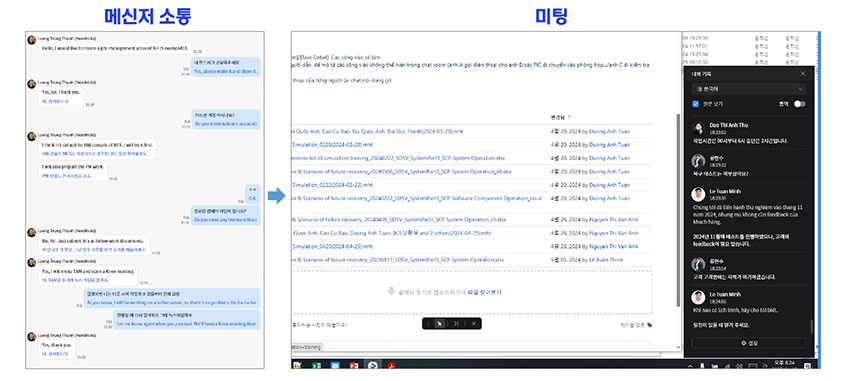 Collaboration with GDC through Samsung SDS Brity Works (Source: New Possibilities Opened by GDC Utilization)
Collaboration with GDC through Samsung SDS Brity Works (Source: New Possibilities Opened by GDC Utilization)
Have you been satisfied with the professionalism of Samsung SDS GDC personnel?
We had a really impressive experience. Our GS ITM infrastructure team leader actually traveled to Vietnam to conduct knowledge transfer for infrastructure operations. At first, we prepared training materials explaining the basic concepts needed for infrastructure management step-by-step.
But once the process began, we found that the Vietnam GDC team members were already very knowledgeable in the relevant technical fields. They already possessed sufficient fundamental infrastructure knowledge, so knowledge transfer focused mainly on our company’s unique infrastructure environment and operational methods. This experience made us realize firsthand how solid the skills of Samsung SDS GDC personnel are. Since these experts undergo rigorous screening at Samsung SDS, their technical expertise was truly reliable.
In fact, China is known for developing innovative AI models like DeepSeek, and India is an undisputed IT powerhouse. There’s a saying that if you don’t get into the Indian Institutes of Technology, you aim for MIT. It means that they are outstanding talents who have passed intense competition. For example, 43% of Accenture’s workforce is Indian. So while wages may be relatively lower in some countries, the abilities of individual personnel are by no means inferior.
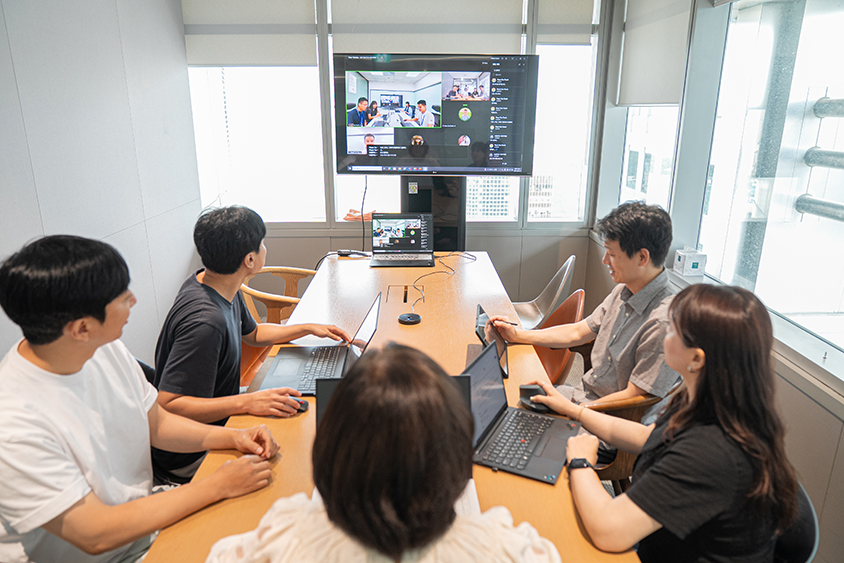 EVP Lee Eunjoo conducting remote meetings with Samsung SDS GDC personnel
EVP Lee Eunjoo conducting remote meetings with Samsung SDS GDC personnel
Remote work has raised concerns about management and quality. How was it in reality?
Our experience with remote work during the COVID-19 was a major turning point. We realized that just as we could perform our tasks smoothly while working from home. There was no reason collaboration with experts in Vietnam or India would be difficult. We recognized that the location of the office—whether Yeoksam-dong, Jukjeon, Yeosu, or Hanoi—no longer mattered in this era.
Furthermore, seeing that the top-tier service quality of Samsung SDS in global IT services was fully applied to the GDC, the remaining concerns gradually disappeared. Samsung SDS holds world-class international quality certifications and software certifications, and these same standards are rigorously applied to and maintained in the GDC.
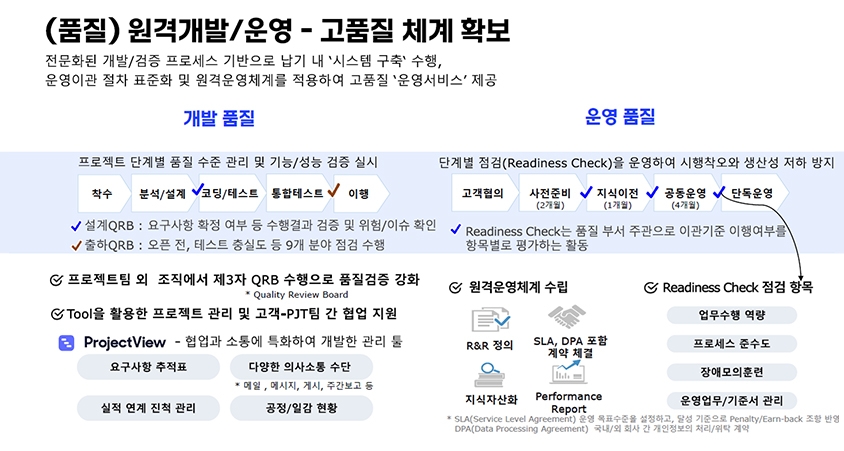 Samsung SDS GDC Development and Operation QA system (Source: New Possibilities Opened by GDC Utilization)
Samsung SDS GDC Development and Operation QA system (Source: New Possibilities Opened by GDC Utilization)
What particularly impressed me was the clear performance management system even including Service Level Agreement (SLA), as well as penalty and earn-back clauses. If commitments are not met, penalties are imposed, and if targets are exceeded, incentives are awarded, ensuring trust and accountability.
What is SLA (Service Level Agreement)?
SLA is a contract that clearly defines service quality standards and performance goals between an IT service provider and a customer. Its importance in GDC especially lies in addressing trust issues that can arise when collaborating with overseas personnel. Concrete targets, such as achieving 99.9% system availability and responding to outages within 30 minutes, are set, and clauses are included to impose penalties if these targets are not met.
Above all, Samsung SDS’s security management track record completely alleviated our concerns. Customer data leakage incidents have never occurred due to their thorough management. While other global IT companies sometimes face security breaches, Samsung SDS operates securely and reliably without such incidents, allowing us to confidently entrust our work.
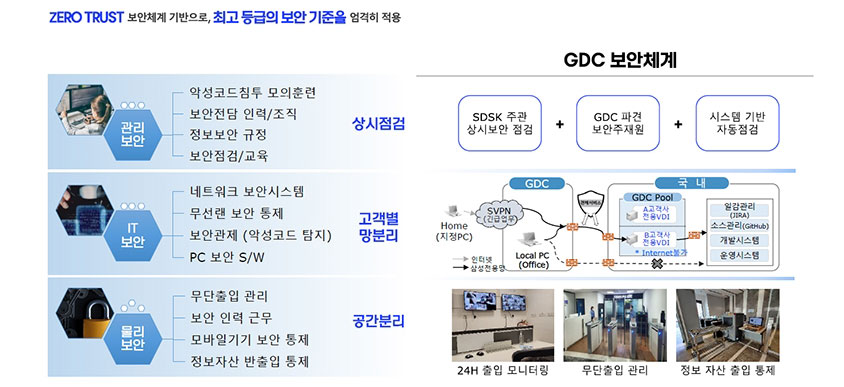 Samsung SDS GDC ZERO TRUST Security System (Source: New Possibilities Opened by GDC Utilization)
Samsung SDS GDC ZERO TRUST Security System (Source: New Possibilities Opened by GDC Utilization)
"We've been able to operate more systems more stably without increasing cost."
Many people are curious about this part — in terms of cost, what kind of real impact have you seen?
We recently prepared our budget for next year’s ERP renewal, and surprisingly, it’s smaller than the one we had ten years ago. Let me explain how remarkable that is. Despite labor costs increasing by more than 50% over the past decade, our overall budget hasn’t grown. Typically, with inflation and technological advancements, you’d expect budgets to rise — but ours actually decreased.
The reason this is possible is because our GDC operations have become well-established, providing equivalent or even better capabilities at a lower cost. All the time and effort we invested in transferring knowledge and building up the GDC team’s competencies are now paying off. After thorough knowledge transfer and systematic training, they’re now fully up to speed, allowing us to maintain high-quality services at a very economical budget.
Currently, we’re experiencing cost efficiency in both development and operations. On the operations side, we can now stably run more systems without additional cost. On the development side, we’ve created an environment that enables more agile development while achieving cost savings. We could clearly see the numbers demonstrating that the GDC is truly making a significant difference.
Interestingly, I heard that the introduction of GDC actually accelerated GS Caltex’s digital transformation. What does it mean?
The biggest achievement from adopting GDC was the improvement in our internal IT capabilities. At first, our goal was simply to reduce operating costs, but in reality, the entire IT operations framework of the company was upgraded to a new level. Since we’re not an IT-specialized company, we had relatively limited capabilities in areas like automation tool utilization, metrics-based quality management, and structured incident response. But through our collaboration with GDC, we naturally absorbed Samsung SDS’s professional operations framework.
The most significant change is that we can now manage operations in a systematic, data-driven way. Previously, decisions were made based largely on experience, but now key metrics such as on-time processing rate, independent resolution rate, process compliance, lead time, and quality satisfaction are all clearly measured and managed.
 Samsung SDS GDC Collaboration Tool ProjectView (Source: New Possibilities Opened by GDC Utilization)
Samsung SDS GDC Collaboration Tool ProjectView (Source: New Possibilities Opened by GDC Utilization)
Another major change was the systematization of our work processes. To transfer tasks to the GDC, we first needed to clearly define our work standards and quality levels. In doing so, we reorganized our internal guidelines and reviewed existing deliverables. In particular, our incident response approach completely transformed. Information such as root causes, resolution methods, and handling times—things we used to jot down on a whiteboard—are now automatically recorded and stored as part of a knowledge base. As tool-based workflows became established, like using Figma for UI design and ProjectView for feedback sharing, it no longer matters whether our teams are in Yeosu, Jukjeon, or Hanoi.
Ultimately, by naturally absorbing the know-how of the professional IT service provider, our internal capabilities grew alongside. The introduction of GDC served as an opportunity to systematize and standardize long-standing work practices. We’re now doing things the way they were always meant to be done.
What is ProjectView?
ProjectView is a project management and collaboration tool developed internally by Samsung SDS. It is an integrated platform specifically designed to support remote development and operations. The core feature of this tool is providing real-time visibility. It simultaneously offers Work Breakdown Structure (WBS) and Gantt charts, supporting the entire project lifecycle from requirements management to testing. ProjectView provides real-time monitoring of tasks performed by GDC personnel, the progress of development, and the quality levels.
"The ability to retain top talent stably is a crucial.”
Based on this experience, if other companies consider adopting a GDC, what would be the most important criteria for selecting a provider?
One reason for hesitation in adopting the GDC was a past experience of losing trust while working with overseas personnel. So when thinking about what is needed to build trust, several key criteria emerged.
First, the expertise and capability of the personnel are crucial. Companies need to verify whether the staff meet the required technical specifications and understand the criteria GDC uses to select its talent. Second, workforce stability is vital. There is a common prejudice that overseas personnel quit quickly, so it’s essential to have confidence that the knowledge and skills transferred will be maintained and that stable service will continue. Effective retention management is key to ensuring staff longevity.
Third, clear contract and quality assurance systems are necessary. No matter how well things are done, if the process is not visible, it is hard to trust. Transparency is needed to check in real-time what tasks overseas personnel working remotely are doing, how much progress has been made in development, and the quality level. Finally, verified security is critical. Especially in industries like oil refining and petrochemicals, security is extremely important. Therefore, we can only entrust work with vendors who have internationally certified security systems.

"Samsung SDS's GDC is a true game changer leading the IT globalization"
Please share a message for those considering the adoption of Samsung SDS’s GDC.
In this era, global expertise truly matters. When we receive a report created by global consulting firms with experts participating remotely from around the world, we often say, “As expected, the involvement of global experts ensures high quality.” But strangely, when it comes to IT operations being led by global experts, people tend to express concern instead. I think that stems from a form of bias.
Just as we trust the quality and stability of the cloud services we use without necessarily knowing where or by whom they are operated, I believe the location of IT operations doesn’t really matter. What truly matters is how capable the people operating the service are—how reliably they can maintain quality and resolve security concerns. Based on my experience, Samsung SDS’s GDC exceeded expectations in every one of these aspects.
For those who may be interested but still unsure if it’s really feasible, I encourage you to have a conversation with Samsung SDS. If you discuss what kind of global outsourcing model best fits your company, you’ll likely find an ideal solution together. And even if you don’t end up adopting GDC, conducting a Proof of Concept (PoC) will be a valuable opportunity to see firsthand how advanced global IT talent has become, and to discover new areas where we ourselves can continue to learn and grow.
Could you describe Samsung SDS GDC in one word?
I would say Samsung SDS GDC is a true game changer driving the globalization of all IT. It’s not only about developing the most advanced technologies for global use, but also about ensuring those technologies are operated stably, without concerns over security or system failures. I believe Samsung SDS is the first in the industry to systemize and provide all of these capabilities.
Experience reliable service, quality, and security with Samsung Standards
Connect with our experts now

B2B marketer with a big passion for data modeling and AI
Deliver accurate insight and wholehearted effort to help customers achieve success